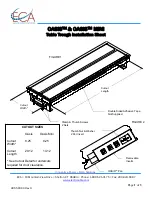
Chapter 5
Setup and Configuration
RUGGEDCOM ROX II
User Guide
704
Benefits of MSTP
Role
Description
A Boundary Port connected to an STP bridge will send only STP BPDUs. One connected to
an RSTP bridge need not refrain from sending MSTP BPDUs. This is made possible by the
fact that the MSTP carries the CIST Regional Root Identifier in the field that RSTP parses
as the Designated Bridge Identifier.
Section 5.34.3.3
Benefits of MSTP
MSTP is configured by default to arrive automatically at a spanning tree solution for each configured MSTI.
However, advantages may be gained from influencing the topology of MSTIs in an MST region by way of the
Bridge Priority and the cost of each port.
Load Balancing
MSTP can be used to balance the data traffic load among sets of VLANs, enabling more complete utilization of a
bridged network that has multiple redundant interconnections between bridges.
A bridged network controlled by a single spanning tree will block redundant links by design to avoid harmful
loops. However, when using MSTP, any given link may have a different blocking state for MSTI, as maintained
by MSTP. Any given link, therefore, might be in blocking state for some VLANs, and in forwarding state for other
VLANs, depending on the mapping of VLANs to MSTIs.
It is possible to control the spanning tree solution for each MSTI, especially the set of active links for each tree, by
manipulating per MSTI the bridge priority and the port costs of links in the network. If traffic is allocated judiciously
to multiple VLANs, redundant interconnections in a bridged network, which would have gone unused when using
a single spanning tree, can now be made to carry traffic.
Isolation of Spanning Tree Reconfiguration.
A link failure in an MSTP region that does not affect the roles of Boundary ports will not cause the CST to be
reconfigured, nor will the change affect other MSTP regions. This is due to the fact that MSTP information does
not propagate past a region boundary.
MSTP versus PVST
An advantage of MSTP over the Cisco Systems Inc. proprietary Per-VLAN Spanning Tree (PVST) protocol is the
ability to map multiple VLANs onto a single MSTI. Since each spanning tree requires processing and memory,
the expense of keeping track of an increasing number of VLANs increases much more rapidly for PVST than for
MSTP.
Compatibility with STP and RSTP
No special configuration is required for the bridges of an MST region to connect fully and simply to non-MST
bridges on the same bridged network. Careful planning and configuration is, however, recommended to arrive at
an optimal network design.
Section 5.34.3.4
Implementing MSTP on a Bridged Network
The following procedure is recommended for configuring MSTP on a network. Beginning with a set of MSTP-
capable Ethernet bridges, do the following for each bridge on the network:
Содержание RUGGEDCOM RX1510
Страница 32: ...RUGGEDCOM ROX II User Guide Preface Customer Support xxxii ...
Страница 44: ...RUGGEDCOM ROX II User Guide Chapter 1 Introduction User Permissions 12 ...
Страница 62: ...RUGGEDCOM ROX II User Guide Chapter 2 Using ROX II Using the Command Line Interface 30 ...
Страница 268: ...RUGGEDCOM ROX II User Guide Chapter 4 System Administration Deleting a Scheduled Job 236 ...
Страница 852: ...RUGGEDCOM ROX II User Guide Chapter 5 Setup and Configuration Enabling Disabling an LDP Interface 820 ...
















































